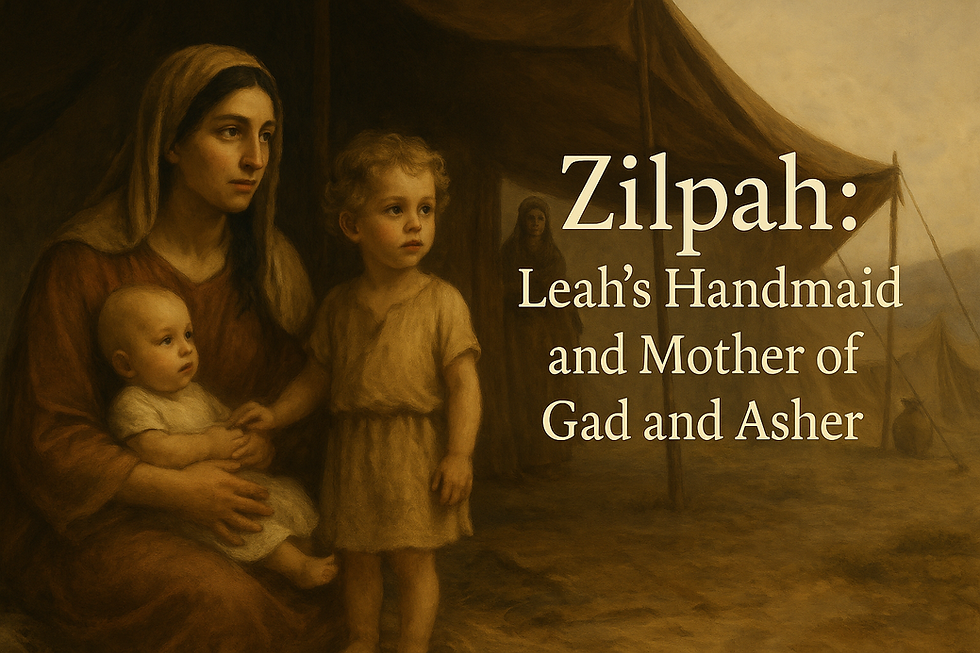Zilpah: Leah’s Handmaid and Mother of Gad and Asher
- Bible Believing Christian

- Sep 5
- 3 min read

Zilpah: Leah’s Handmaid and Mother of Gad and Asher
Zilpah, though mentioned only briefly in Scripture, played a role in shaping the house of Israel. As Leah’s handmaid, she was given to Jacob to bear children on Leah’s behalf during the rivalry with Rachel. Through her, Jacob fathered Gad and Asher, two of the twelve tribes. Zilpah’s story reflects how God used even the struggles and schemes of human families to accomplish His covenant plan.
Name & Etymology
The name Zilpah (זִלְפָּה, Zilpāh, pronounced zil-pah) may mean “trickling” or “a drooping.” In the Septuagint, her name appears as Zelpha (Ζελφά). The meaning suggests humility or lowliness, fitting her role as a servant.
Biblical Narrative (The Story)
When Leah saw that she was no longer bearing children, she gave her servant Zilpah to Jacob as a wife (Genesis 30:9). Through Zilpah, Jacob had two sons:
Gad, named by Leah: “How fortunate I am!” (Genesis 30:11, NLT).
Asher, named by Leah: “What joy is mine! Now the other women will celebrate with me” (Genesis 30:13, NLT).
Though Zilpah acted at Leah’s command, her children were counted among the sons of Jacob and became tribes of Israel.
Historical & Cultural Context
As with Bilhah, Zilpah’s story reflects the practice in the ancient Near East of using maidservants as surrogates when wives struggled with fertility. This created rivalry and tension but also expanded family lines.
Zilpah’s role demonstrates both the vulnerability of servants in patriarchal households and the surprising way their children could rise to full tribal status within Israel.
Character & Themes
Zilpah is portrayed with little personal detail, but her life highlights themes of humility, subordination, and God’s providence. Though she lived in the background, her sons carried forward the covenant family.
Themes in her story include:
God’s use of the lowly to accomplish great purposes.
The tension of human rivalry and divine blessing.
The inclusion of servants’ children into the full inheritance of Israel.
Connection to Christ
Through Zilpah’s sons, the tribes of Gad and Asher became part of God’s covenant people. Christ came not only through Judah but for all the tribes, including those born of handmaids.
Her story foreshadows the way Christ would later elevate the lowly, showing that God’s kingdom includes those often overlooked by the world.
Theological Significance
Zilpah’s life reminds us that God’s plan of salvation is not limited to the powerful or favored. Her sons were fully included in Israel, proving that God’s promises extend to those born in humility and obscurity.
Theologically, her role illustrates God’s sovereignty over family conflicts and cultural customs. Even human rivalry cannot derail His redemptive plan.
Myths & Misconceptions
One misconception is that Zilpah was merely incidental. In reality, her sons were fully recognized as tribes of Israel, confirming her essential place in the story.
Another misconception is that her children were second-class. Scripture makes no distinction—the tribes of Gad and Asher received inheritance alongside the others.
Application
Zilpah’s story challenges us to see God’s value in those the world may overlook. It encourages faith that God can use anyone, regardless of background or status, to fulfill His purposes.
Her life speaks to those who feel sidelined: God sees you, and He can bring forth fruit through your faithfulness.
Conclusion
Zilpah, Leah’s handmaid, became the mother of Gad and Asher, two tribes of Israel. Though a servant caught in rivalry, her children stood as full heirs in God’s covenant family. Her story reminds us that God works through the overlooked to bring about His plan of salvation, pointing ultimately to Christ, who welcomes all into His kingdom.


